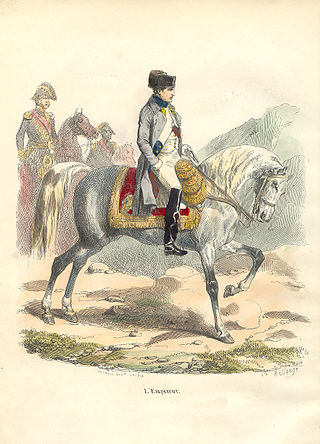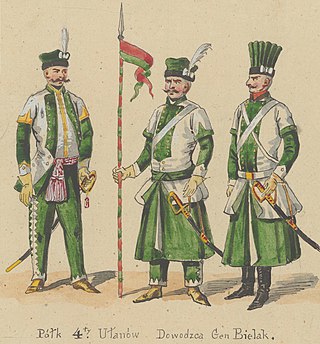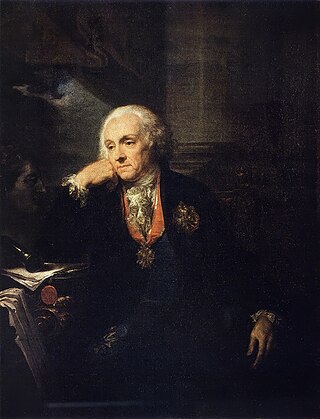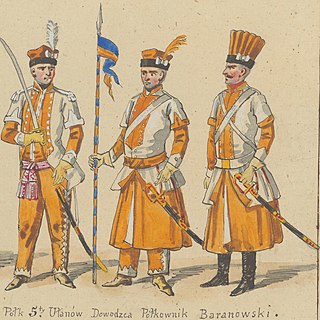Related Research Articles
White Ruthenia is one of the historical divisions of Kievan Rus' according to the color scheme, which also includes Black and Red Ruthenia. In the Late Middle Ages and Early Modern period, the name White Ruthenia was characterized by instability, designating a number of different regions on the territory of modern Belarus, Russia, and Ukraine. It is recorded mainly in Western European sources, starting from the middle of the 13th century.

The coat of arms of the Polish–Lithuanian Commonwealth represented the union of the Crown of the Polish Kingdom and Grand Duchy of Lithuania.

The uniforms of La Grande Armée, the army of Napoleon I, are described in this article.

The 4th Lithuanian Vanguard Regiment was a military unit of the Grand Duchy of Lithuania. The full name was 4th Lithuanian Advance Guard Regiment of Josef Bielak.

Ludwik Skumin Tyszkiewicz was a Polish–Lithuanian nobleman (szlachcic) and Field Lithuanian Hetman from 1780 to 1791, Great Lithuanian Treasurer from 1791, Great Lithuanian Marshal from 1793. Member of the Targowica Confederation.

The National cavalry was a branch of Polish–Lithuanian cavalry in the Polish-Lithuanian armed forces in the last quarter of the 18th century. Formed as a merger of previously-existing units of Winged hussars, pancerni and petyhorcy that were still in service after the Confederation of Bar. In 1777 the Sejm new regulations converted all units of heavy cavalry and medium cavalry and reformed them into a line cavalry, roughly similar to later uhlans popular in Europe in the 19th century. Existing dragoon and Front or Vanguard Regiments were outside this reform The National Cavalry had a very short history of 20 years, and some units stationed in the eastern Polish–Lithuanian Commonwealth were forcibly incorporated into the Russian cavalry following the Second Partition of Poland, and the remainder was disbanded together with the rest of Polish–Lithuanian armed forces after the final partition in 1795. The Sejm's 1777 decision was a rather late effort to modernize Polish–Lithuanian cavalry, along with the much earlier trend of evolution of European cavalry towards the more modern organization of the cavalry regiments into more mobile formations. The most modern part of the reform was the establishment of some very modern battle dress uniforms for these cavalrymen, and in turn, this uniform of the National Cavalry inspired numerous similar uniforms and employment of 'Polish lance' in the rest of Europe, notably the Austrian, Prussian, Russian cavalry, and later of the French cavalry of the Napoleonic Wars.
Jūratė Kiaupienė is a Lithuanian historian, professor, Habilitated Doctor.

Joachim Litawor Chreptowicz, of Odrowąż Coat of Arms, was a Polish-Lithuanian nobleman, writer, poet, politician of the Grand Duchy of Lithuania, marshal of the Lithuanian Tribunal, and the last Grand Chancellor of Lithuania. He was a member of the Permanent Council, activist of the Commission of National Education, physiocrat and a vivid supporter of the Targowica Confederation. He also founded the library of the Counts of Chreptowicz in Szczorsy, which was augmented by his son and contained over 10,000 volumes, including valuable collections of Polish histories from the 16th to 18th centuries.

The 5th Lithuanian Vanguard Regiment was a military unit of the Grand Duchy of Lithuania. The full name was 5th Lithuanian Advance Guard Regiment of Stanisław Byszewski.
The 3rd Lithuanian Vanguard Regiment was a military unit of the Grand Duchy of Lithuania. The full name was 3rd Advance Guard Regiment Field Hetman of Lithuania Antoni Chlewinkiego.

The 8th Lithuanian Cavalry Regiment was a military unit of the Grand Duchy of Lithuania, raised during the Kościuszko Uprising.

The 3rd Lithuanian National Cavalry Brigade was a military unit of the Grand Duchy of Lithuania led by Józef Antoni Kossakowski.
The 2nd Lithuanian Vanguard Regiment was a military unit of the Grand Duchy of Lithuania. The full name was 2nd Advance Guard Regiment Grand Hetman of Lithuania Josef Jelenski.
The 1st Lithuanian Vanguard Regiment was a military unit of the Grand Duchy of Lithuania. The full name was 1st Advance Guard Regiment of HM the Grand Duke of Lithuania.
The 6th Lithuanian Vanguard Regiment was a military unit of the Grand Duchy of Lithuania. It was also named:

The Danielewicz family of Clan Ostoja originates probably from Russian boyar Daniel Aleksandrowicz's son Vladimir Danielewicz, that settled down in Lithuania. Danielewicz is a patronymic surname, meaning descendants of Daniel or Danilo. The family is associated with the Clan of Ostoja and Ostoja Coat of Arms.
The Lithuanian Rifle Corps was a riflemen unit of the Grand Duchy of Lithuania.
The Neapolitan Regiment of Honour Guards was a royal bodyguard unit of the Royal Neapolitan Guard, and was in turn part of the wider Neapolitan Army. The regiment was formed following the succession of Joachim Murat, and would continue to act as the official bodyguard under different designations until its eventual disbandment in 1815 following the disastrous Neapolitan War.

The Danilewicz (Danielewicz) family – a noble family from the Grand Duchy of Lithuania, with the coat of arms of Ostoja, belonging to the heraldic Clan Ostoja (Moscics). The Danilewicz’s were mentioned by Kasper Niesiecki in Herbarz Polski.
Stanisław Plater was a Polish-Lithuanian historian, geographer, officer.
References
- 1 2 3 4 5 6 Rospond 2013, p. 39; Tartar Regiment of Alexander Ulano - a.k.a. 7th Regiment of Tartars of the Grand Duchy of Lithuania (7 Pulk Tartarski Wielkiego Ksiestwa Litewskiego).
(F) May 1792.
(S) Janow. Pressed into service of Targowica Confederation (Oct 1792).
Red czapka with black lambswool band and white plume, and single left-hand white epaulette. The saddle cloth was red with white edging. - ↑ Norris 2009.